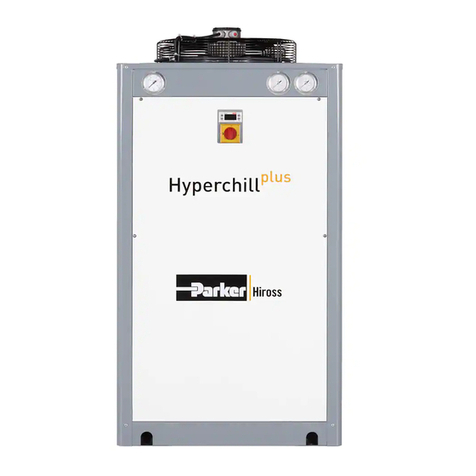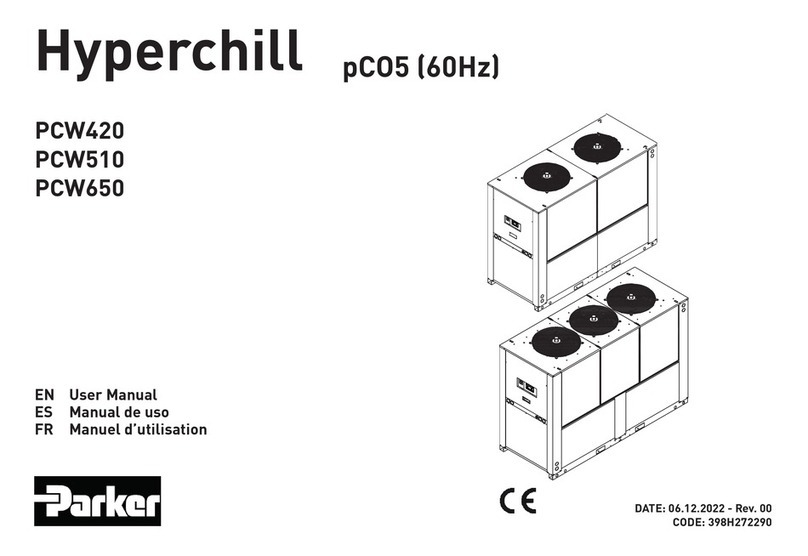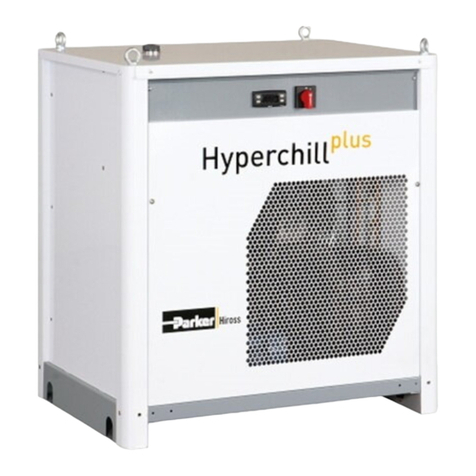
Italiano 3/10
Hyperchiller 076-116
pianto in corrispondenza ai mesi più freddi dell’anno, l’acqua
all’interno del circuito ghiacci.
Per evitare questo pericolo si può:
a) Dotare il refrigeratore di adeguate protezioni antigelo, forni-
te dal costruttore come opzionali;
b) Scaricare l’impianto tramite l’apposita valvola di scarico, in
caso di fermate prolungate;
c) Aggiungere un’adeguata quantità di antigelo all’acqua di
circolazione (vedi tabella).
A volte la temperatura dell’acqua in uscita è tale da richiede-
re che essa venga miscelata con glicole etilenico, per evitare
formazioni di ghiaccio, nelle percentuali sotto riportate.
Temperatura acqua
in uscita [°C]
Glicole etilenico
(% vol.)
Temperatura
ambiente
45-2
210-5
015-7
-2 20 -10
-4 25 -12
-6 30 -15
3.4.3 Vaso d’espansione
Per evitare che gli aumenti o diminuzioni di volume del uido
conseguenti ad una variazione sensibile della sua temperatura
possano danneggiare la macchina o il circuito, è consigliabile
installare un vaso d’espansione di capacità adeguata.
Il vaso d’espansione va installato in aspirazione alla pompa
sull’attacco posteriore del serbatoio.
Per un calcolo del volume del vaso d’espansione da applicare
ad un circuito chiuso si può utilizzare la formula seguente:
V=2 x Vtot x (Pt min - P t max)
dove
Vtot= vol. totale del circuito (in litri)
P t min/max = peso specico alla minima/massima temperatura
raggiungibile dall’acqua [kg/dm3].
I valori di peso specico in funzione della temperatura e della
percentuale di glicole, sono riportati in tabella.
%
glico-
le
Temperatura [°C]
-100 1020304050
0% 1.0024 1.0008 0.9988 0.9964 0.9936 0.9905 0.9869
10% 1.0177 1.0155 1.0130 1.0101 1.0067 1.0030 0.9989
20% 1.0330 1.0303 1.0272 1.0237 1.0199 1.0156 1.0110
30% 1.0483 1.0450 1.0414 1.0374 1.0330 1.0282 1.0230
!Attenzione: In fase di riempimento fare riferimento ai
dati di carica anche del vaso di espansione.
3.5 Circuito elettrico
3.5.1 Controlli e collegamenti
!Prima di effettuare qualsiasi operazione su parti elettriche
assicurarsi che non vi sia tensione.
Tutte le connessioni elettriche devono essere conformi alle
prescrizioni locali del luogo di installazione.
Controlli iniziali
1) La tensione e la frequenza di rete devono corrispondere
ai valori stampigliati sulla targhetta dati del refrigeratore.
La tensione di alimentazione non deve, neppure per brevi
periodi, essere fuori dalla tolleranza riportata sullo schema
elettrico che, salvo diverse indicazioni, è pari +/- 10% per la
tensione; +/- 1% sulla frequenza.
2) La tensione deve essere simmetrica (valori efcaci delle
tensioni ed angoli di fase fra fasi consecutive uguali fra loro).
Il massimo squilibrio ammesso fra le tensioni è pari al 2%
Collegamento
1) L’alimentazione elettrica dei refrigeratori viene effettuata
con cavo a 4 li , 3 poli +terra, senza neutro. Per la sezione
vedere paragrafo 7.5.
2) Passare il cavo attraverso il pressacavo posto sul pannel-
lo posteriore della macchina e collegare fase e neutro ai
morsetti del sezionatore generale (QS), la terra va collegata
all’apposito morsetto di terra (PE).
3) Assicurare all’origine del cavo di alimentazione una protezio-
ne contro i contatti diretti pari ad almeno IP2Xo IPXXB.
4)Installare , sulla linea di alimentazione elettrica del refrigera-
tore, un interruttore automatico con differenziale 0.3A, della
portata massima indicata nello schema elettrico di riferimen-
to, con potere di interruzione adeguato alla corrente di corto
circuito esistente nella zona d’installazione della macchina.
La corrente nominale “In” di tale magnetotermico deve esse-
re uguale a FLA e la curva di intervento di tipo D.
5) Valore massimo dell’impedenza di rete = 0.274 ohm.
Controlli successivi
Assicurarsi che la macchina e le apparecchiature ausiliarie
siano state messe a terra e protette contro cortocircuiti e/o
sovraccarichi.
!Una volta che l’unità è stata collegata e l’interruttore
generale a monte è stato chiuso (dando così tensione alla
macchina), il voltaggio nel circuito elettrico raggiunge valori
pericolosi. Massima precauzione!
3.5.2 Allarme generale
Tutti i refrigeratori sono provvisti della segnalazione allarme
macchina (vedere schema elettrico), costituita da un contatto
libero in scambio riportato in morsettiera: ciò permette di allac-
ciare un allarme centralizzato esterno, acustico, visivo o inserito
in logiche es. PLC.
3.5.3 ON/OFF remoto
Tutti i refrigeratori hanno la possibilità di avere un comando di
avviamento e fermata remoto.
Per il collegamento del contatto ON-OFF remoto vedere lo
schema elettrico.
3.6 Versione ad acqua (W)
I chiller in versione con condensazione ad acqua, necessitano
di un circuito idraulico che porti l’acqua fredda al condensatore.
Il chiller in versione ad acqua è dotato di una valvola presso-
statica, in entrata al condensatore, la cui funzione è quella di
regolare la portata d’acqua in modo da ottenere sempre una
condensazione ottimale.
Controlli preliminari
Se l’alimentazione di acqua al condensatore viene realizzata
tramite circuito chiuso, effettuare tutti i controlli preliminari elen-
cati per il circuito idraulico principale (paragrafo 3.3.1).
Collegamento
1) Si consigliadidotare il circuito acqua di condensazione di
valvole di intercettazione, in modo da poter escludere la mac-
china in caso di manutenzione.
2) Collegare le tubazioni dimandata/ritorno acqua agli appositi
attacchi posti sul retro dell’unità.
3) Se l’acqua di condensazione è ” a perdere”, si consiglia di
dotare il circuito di un ltro in ingresso al condensatore, in
modo da limitare il rischio di sporcamento delle superci.
4) Se il circuito è di tipo chiuso, vericare che sia ben riempito
d’acqua e correttamente satato dall’aria.


































